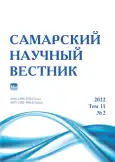Equestrian cohors amicorum in the system of social ties in the early Roman Empire
- Authors: Telepen S.V.1
-
Affiliations:
- Mozyr State Pedagogical University named after I.P. Shamyakin
- Issue: Vol 11, No 2 (2022)
- Pages: 183-188
- Section: Historical Sciences
- URL: https://journals.rcsi.science/2309-4370/article/view/109847
- DOI: https://doi.org/10.55355/snv2022112205
- ID: 109847
Cite item
Full Text
Abstract
The paper analyzes cohors amicorum («cohort of friends») as one of the institutions of social organization and political system of the early Roman Empire. Based on the study of mainly literary sources, the origin of this institution and its role in strengthening the social positions of the equites, that is, Roman horsemanship, are investigated. The ambiguity of the concept of cohors amicorum is argued, which is considered in connection with the analysis of such concepts as amici («friends») and comites («companions») of the princeps, as well as amicitia («friendship») in their specific Roman sense. The paper substantiates a largely informal nature of the cohors amicorum, which was determined by a specific system of social ties during the period of the Principate. This system did not imply the formalization of all forms of social life, as it was based on polis traditions. Based on the results of the study, it is concluded that in the early Roman Empire, clans and groups formed, only partially formalized, where complex relations intersected, not reducible to their official forms. The principle of personal and moral (in the Roman sense) responsibility determined the fulfillment by all parties of amicitia of traditional duties, in connection with which the members of the cohors amicorum had the opportunity to strengthen their social status, which during the period of the Principate was most relevant for the equites, who gradually became the main personnel resource of the princeps.
Full Text
##article.viewOnOriginalSite##About the authors
Sergey Valeryevich Telepen
Mozyr State Pedagogical University named after I.P. Shamyakin
Author for correspondence.
Email: telepen_serg@mail.ru
candidate of historical sciences, associate professor of History and Social Sciences Department
Belarus, Mozyr, Gomel RegionReferences
- Межерицкий Я.Ю. «Восстановленная республика» императора Августа. М.: Русский фонд содействия образованию и науке, 2016. 992 с.
- Абрамзон М.Г. Монеты как средство пропаганды официальной политики Римской империи. М., 1995. 656 с.
- Смирнова Е.Л. Флавии и всадническое сословие // Мнемон: Исследования и публикации по истории античного мира. 2016. № 16-1. С. 101-116.
- Крист К. История времен римских императоров от Августа до Константина. В 2 т. Т. 1 / пер. с нем.: Ростов-на-Дону: Изд-во «Феникс», 1997. 576 с.
- Millar F. The Emperor and the Roman World. London: Duckworth, 1977. 656 p.
- Crook J. Consilium principis. Imperial Councils and Counsellors from Augustus to Diocletian, Cambridge: University Press, 1955. 198 p.
- Saller R.P. Promotion and patronage in equestrian careers // Journal of Roman Studies. 1980. Vol. 70. P. 44-63.
- Alfoldy G. Die stellung der ritter in der führungsschicht des Imperium Romanum // Chiron. 1981. Bd. 11. S. 169-215.
- Taylor L.R. Party politics in the age of Caesar. Sather classical lectures. Vol. XXII. Berkeley and Los Angeles: University of California Press; London: Cambridge University Press, 1949. 255 p.
- Brunt P.A. «Amicitia» in the Late Republic // The Crisis of the Roman Republic / ed. by R. Seager. Cambridge: Heffer, Barnes & Noble, 1969. P. 199-218.
- Demougin S. L’ordre equestre sous les Julio-claudiens. Rome: Ecole Française de Rome, 1988. 923 р.
- Syme R. Some friends of the Caesars // Roman Papers. Vol. I / ed. by E. Badian. Oxford: The Clarendon Press, 1979. P. 292-299.
- Syme R. The Roman revolution. Oxford: Clarendon Press, 1939. 568 p.
- Mommsen T. Zur lebensgeschichte des Jüngeren Plinius // Hermes. 1869. Bd. 3, hft. 1. S. 31-139.
- Pflaum H.-G. La Gaule et l’Empire romain, études épigraphiques (Scripta Varia II). Paris: L’Harmattan, 1981. 469 p.
- Cotton H.M. Documentary letters of recommendation in Latin from the Roman Empire. Königstein im Taunus: Anton Hain, 1981. 54 р.
- Demougin S. Prosopographie des chevaliers romains Julio-Claudiens (43 av. J.-C. - 70 ap. J.-C.). Rome: École française de Rome, 1992. 719 p.
- Syme R. History in Ovid. Oxford: Clarendon Press, 1978. 240 p.
- Смышляев А.Л. Римский наместник в провинциальном городе: стиль управления в эпоху принципата // Древнее право. 2006. № 1 (17). С. 65-72.
- Малые римские историки. Веллей Патеркул. Римская история. Анней Флор. Две книги Римских войн. Луций Ампелий. Памятная книжица / пер. с лат.; изд. подгот. А.И. Немировским. М.: Науч.-изд. центр «Ладомир», 1995. 387 с.
- Saller R.P. Personal patronage in the Early Roman Empire. Cambridge: Cambridge University Press, 1982. 222 p.
- Телепень С.В. Римские всадники во главе провинциального управления // Современная научная мысль. 2020. № 4. С. 119-125.
- Veyne P. Le pain et le cirque: sociologie historique d’un pluralisme politique. Paris: Ed. du Seuil, 1976. 896 p.
- Махлаюк А.В. Солдаты Римской империи. Традиции военной службы и воинская ментальность. СПб.: Изд. СПбГУ; Изд-во «Акра», 2006. 440 с.
- Pekary Th. Tiberius und der Tempel der Concordia in Rom // Romische Mitteilungen. 1967. № 73/74. S. 105-133.
- Парфенов В.Н. Домициан и его «генералилет» // История: мир прошлого в современном освещении: сб. науч. ст. к 75-летию со дня рожд. профессора Э.Д. Фролова / под ред. А.Ю. Дворниченко. СПб.: Изд-во Санкт-Петербургского университета, 2008. С. 327-336.
Supplementary files






